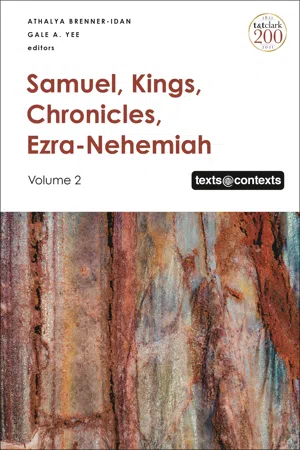![]()
Part I
SAMUEL
![]()
‘DAVID HATES THE LAME AND THE BLIND’: TOWARDS AN INTER(CON)TEXTUAL READING OF 2 SAMUEL 5.6-9*
Dominic S. Irudayaraj
The king and his men marched to Jerusalem against the Jebusites, the inhabitants of the land, who said to David, ‘You will not come in here, even the blind and the lame will turn you back’ – thinking, ‘David cannot come in here.’ Nevertheless, David took the stronghold of Zion, which is now the city of David. David had said on that day, ‘Whoever wishes to strike down the Jebusites, let him get up the water shaft to attack the lame and the blind, those whom David hates.’ Therefore it is said, ‘The blind and the lame shall not come into the house.’ David occupied the stronghold, and named it the city of David. David built the city all around from the Millo inwards.
(2 Sam. 5.6-9, NRSV)
1. Introduction
Double Trouble. Hate rhetoric hurts. And when hateful words are hurled out by persons of prominent profile, they are all the more appalling. Two instances of hate rhetoric are the focus of this essay: one ancient, the other current. The current one was unveiled when Mr Yogi Adithyanath (hereafter, the Yogi) – the political head of Uttar Pradesh, the most populous state in India – was addressing a public gathering. With an oratory that is characteristic of the Yogi, he declared: ‘If they [the Muslims] kill even one Hindu, we will kill [he paused and cried out] … 101!’ (Crabtree 2017).1
That this unrestrained ‘call to kill’ could be uttered in 2017 makes it all the more ominous, as the said year marked the twenty-fifth anniversary of the infamous incident of the destruction of Babri Masjid (a sixteenth-century mosque) by a Hindu right-wing group, which led to nationwide riots and the merciless murdering of over 2,000 people both Hindus and Muslims.2 The Yogi’s outburst is not an exception in the current socio-political context of India where increasing instances of anti-Muslim, anti-Christian and anti-Minority atrocities are amply attested.3 As a Christian from India, when I hear these words of the Yogi, they constitute the first trouble.
The second trouble stems from the very pages of the book that is normative to me and my faith community: the Bible. It concerns an event in David’s life, which records that ‘David hates (
) the lame and the blind’ (2 Sam. 5.8).
4 When such hate words are heard from David, whose centrality in the Bible can hardly be missed by even a cursory reader, they present a formidable problem.
5 This essay aims to undertake an inter(con)textual reading
6 of these two cases of hate rhetoric. Following this reading strategy, I as ‘contextualized’ reader, who is baffled by the
excess in the Yogi’s calumnious call, endeavour to read the biblical instance of hatred for any
excess therein by situating the text in its literary ‘context’. In order to cull out such
excesses, the findings of New Historicism function here as methodological guideposts.
Accordingly, I will proceed as follows: (i) retracing the dominant storyline of David’s Jerusalem takeover, where his hatred for the lame and the blind is hinted at; (ii) informed by New Historicism insights, will attempt a rereading of the same pericope with a view to elucidating the excess in it; (iii) will glean the findings around a heuristic term: proximate ‘other’; and (iv) finally, informed by these findings of a ‘contextualized’ text, an interpretive ramification for the chosen text and a pastoral significance for my Indian ‘context’ are indicated.
2. David’s Jerusalem Takeover: The Narrative Portrayal
Commenting on the biblical portrayal of David, Walter Brueggemann exclaims: ‘The literature and the faith of Israel are endlessly fascinated with David’ (Brueggemann 1985:113), as abounding references to his name7 amply attest. Equally exalted is Jerusalem,8 together with its synonymous poetic name, Zion.9 The chosen text (2 Sam. 5.6-9)10 paints in broad strokes how this central figure of Israel’s historiographical memories comes to possess the religiously noteworthy locus.11 Given this double importance of David and Jerusalem, it is hardly surprising that much scholarly ink has been spent on the motive(s) behind David’s choice of Jerusalem: could it be because of its geographical, strategic location? Or, is it due to David’s political savviness, as Jerusalem belonged to neither the southerners nor the northerners?12 Or, is it on account of the historical importance that is accorded to this city?13 Or, finally and in a proleptic sense, is it due to the future religious significance that this city would garner? Proposals are many and so consensus is hard to come by. As with David’s motives, scholarly efforts have also been spent in searching for the details of the takeover. But such ventures have been vexed by both the brevity14 and obscurity15 of the text. Despite the said paucity and obscurity, the takeover incident still leaves a number of notable features that are pertinent for the present discussion.
‘His Men’. A key feature concerns David’s accompanying forces. David marches into Jerusalem with ‘his men’ (
, v. 6). By relying neither on the Judahite base nor on the northern tribes, David’s choice of his ‘personal army’ – to borrow Gordon’s phrase (Gordon 1986: 226) – may indicate that the credit of the takeover would solely rest with him. And this is made all the more clear when David calls the city after his name (v. 9; cf. v. 7). In other words, as Albrecht Alt avers, ‘Jerusalem became David’s own property’.
16 The King’s Activities. Another notable feature concerns the occupants of Jerusalem. ‘Jebusites (
)’
17 is their name. And they are described as ‘the inhabitants’ (
)
18 of the land. Both details are significant. In the Pentateuch, the Jebusites typically feature in the litany of the n...




